University Accounting: Strategic Management Approaches Report
VerifiedAdded on 2021/05/30
|11
|3004
|28
Report
AI Summary
This report provides a comprehensive analysis of strategic management approaches, including resource-based, market-based, and stakeholder strategies. It delves into the viability, suggested benefits, implementation issues, and limitations of each approach. The resource-based view emphasizes internal resources for competitive advantage, while the market-based strategy focuses on pricing and market dynamics. The stakeholder approach highlights the importance of considering various stakeholders for long-term success. The report explores the strengths and weaknesses of each strategy, offering a detailed overview of their application and impact on organizational goals. The report also includes an introduction, conclusion, and references to support the arguments made in the report.

Running head: BACHELOR OF ACCOUNTING
Bachelor of Accounting
Name of Student:
Name of University:
Author’s Note:
Bachelor of Accounting
Name of Student:
Name of University:
Author’s Note:
Paraphrase This Document
Need a fresh take? Get an instant paraphrase of this document with our AI Paraphraser
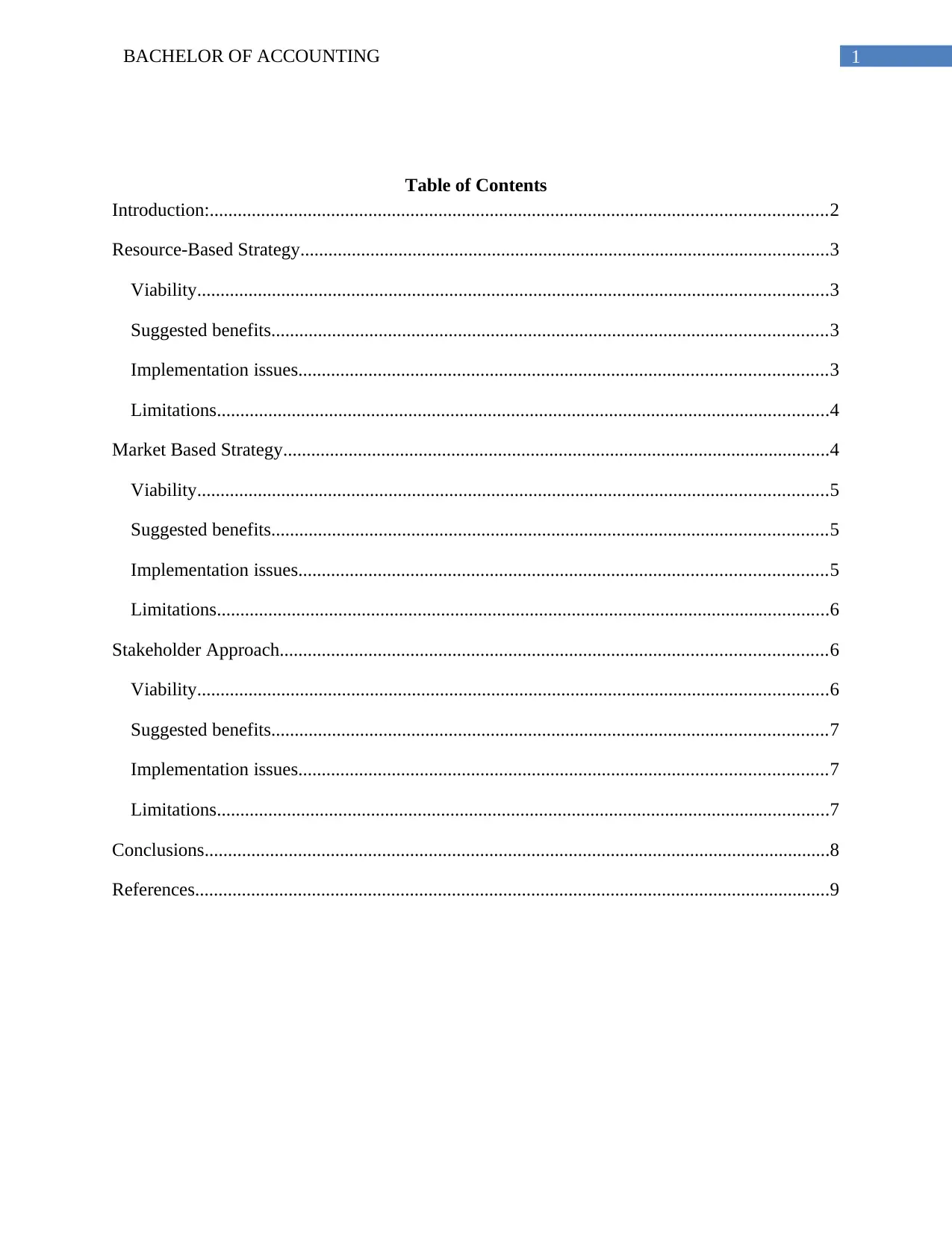
1BACHELOR OF ACCOUNTING
Table of Contents
Introduction:....................................................................................................................................2
Resource-Based Strategy.................................................................................................................3
Viability.......................................................................................................................................3
Suggested benefits.......................................................................................................................3
Implementation issues.................................................................................................................3
Limitations...................................................................................................................................4
Market Based Strategy.....................................................................................................................4
Viability.......................................................................................................................................5
Suggested benefits.......................................................................................................................5
Implementation issues.................................................................................................................5
Limitations...................................................................................................................................6
Stakeholder Approach.....................................................................................................................6
Viability.......................................................................................................................................6
Suggested benefits.......................................................................................................................7
Implementation issues.................................................................................................................7
Limitations...................................................................................................................................7
Conclusions......................................................................................................................................8
References........................................................................................................................................9
Table of Contents
Introduction:....................................................................................................................................2
Resource-Based Strategy.................................................................................................................3
Viability.......................................................................................................................................3
Suggested benefits.......................................................................................................................3
Implementation issues.................................................................................................................3
Limitations...................................................................................................................................4
Market Based Strategy.....................................................................................................................4
Viability.......................................................................................................................................5
Suggested benefits.......................................................................................................................5
Implementation issues.................................................................................................................5
Limitations...................................................................................................................................6
Stakeholder Approach.....................................................................................................................6
Viability.......................................................................................................................................6
Suggested benefits.......................................................................................................................7
Implementation issues.................................................................................................................7
Limitations...................................................................................................................................7
Conclusions......................................................................................................................................8
References........................................................................................................................................9
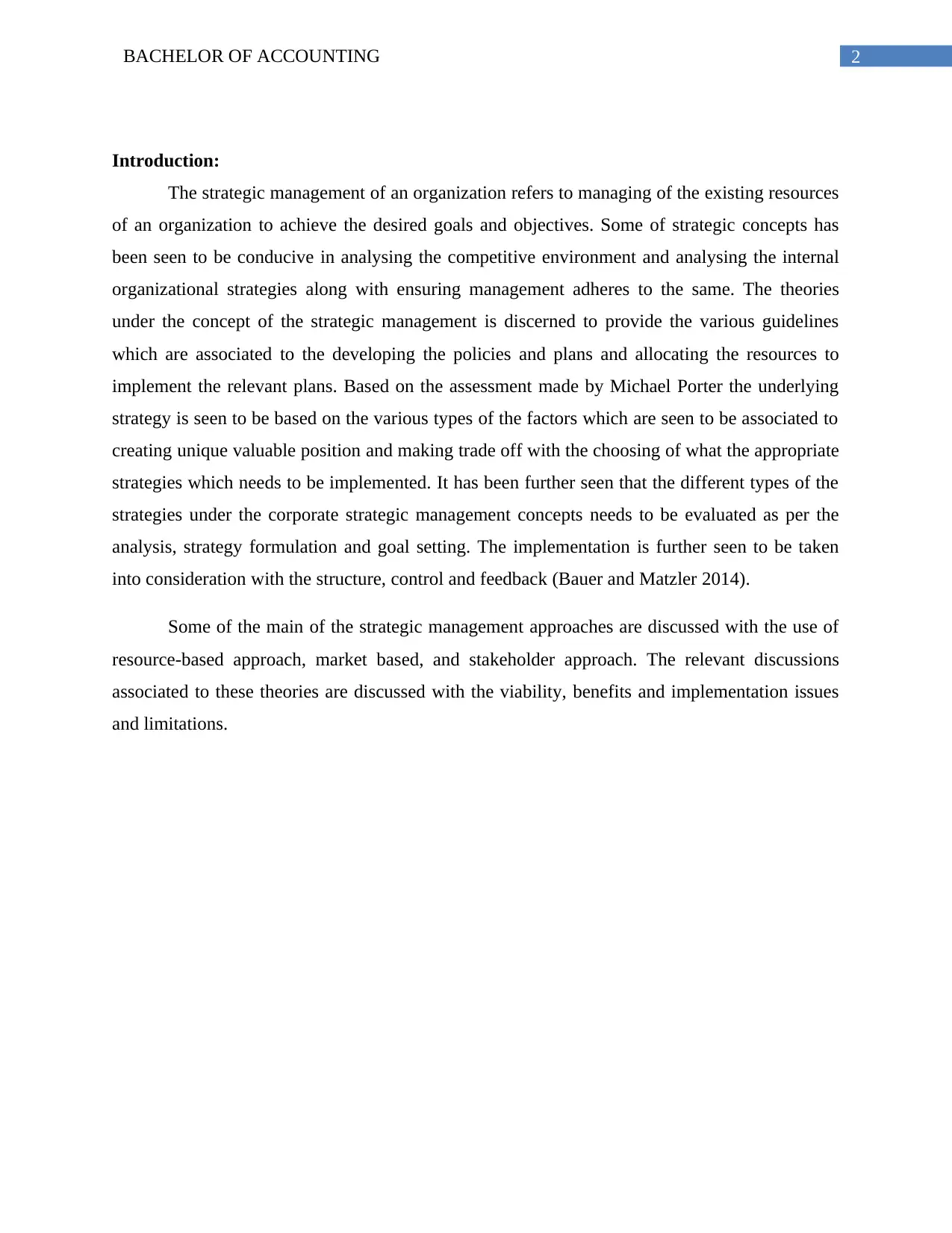
2BACHELOR OF ACCOUNTING
Introduction:
The strategic management of an organization refers to managing of the existing resources
of an organization to achieve the desired goals and objectives. Some of strategic concepts has
been seen to be conducive in analysing the competitive environment and analysing the internal
organizational strategies along with ensuring management adheres to the same. The theories
under the concept of the strategic management is discerned to provide the various guidelines
which are associated to the developing the policies and plans and allocating the resources to
implement the relevant plans. Based on the assessment made by Michael Porter the underlying
strategy is seen to be based on the various types of the factors which are seen to be associated to
creating unique valuable position and making trade off with the choosing of what the appropriate
strategies which needs to be implemented. It has been further seen that the different types of the
strategies under the corporate strategic management concepts needs to be evaluated as per the
analysis, strategy formulation and goal setting. The implementation is further seen to be taken
into consideration with the structure, control and feedback (Bauer and Matzler 2014).
Some of the main of the strategic management approaches are discussed with the use of
resource-based approach, market based, and stakeholder approach. The relevant discussions
associated to these theories are discussed with the viability, benefits and implementation issues
and limitations.
Introduction:
The strategic management of an organization refers to managing of the existing resources
of an organization to achieve the desired goals and objectives. Some of strategic concepts has
been seen to be conducive in analysing the competitive environment and analysing the internal
organizational strategies along with ensuring management adheres to the same. The theories
under the concept of the strategic management is discerned to provide the various guidelines
which are associated to the developing the policies and plans and allocating the resources to
implement the relevant plans. Based on the assessment made by Michael Porter the underlying
strategy is seen to be based on the various types of the factors which are seen to be associated to
creating unique valuable position and making trade off with the choosing of what the appropriate
strategies which needs to be implemented. It has been further seen that the different types of the
strategies under the corporate strategic management concepts needs to be evaluated as per the
analysis, strategy formulation and goal setting. The implementation is further seen to be taken
into consideration with the structure, control and feedback (Bauer and Matzler 2014).
Some of the main of the strategic management approaches are discussed with the use of
resource-based approach, market based, and stakeholder approach. The relevant discussions
associated to these theories are discussed with the viability, benefits and implementation issues
and limitations.
⊘ This is a preview!⊘
Do you want full access?
Subscribe today to unlock all pages.

Trusted by 1+ million students worldwide
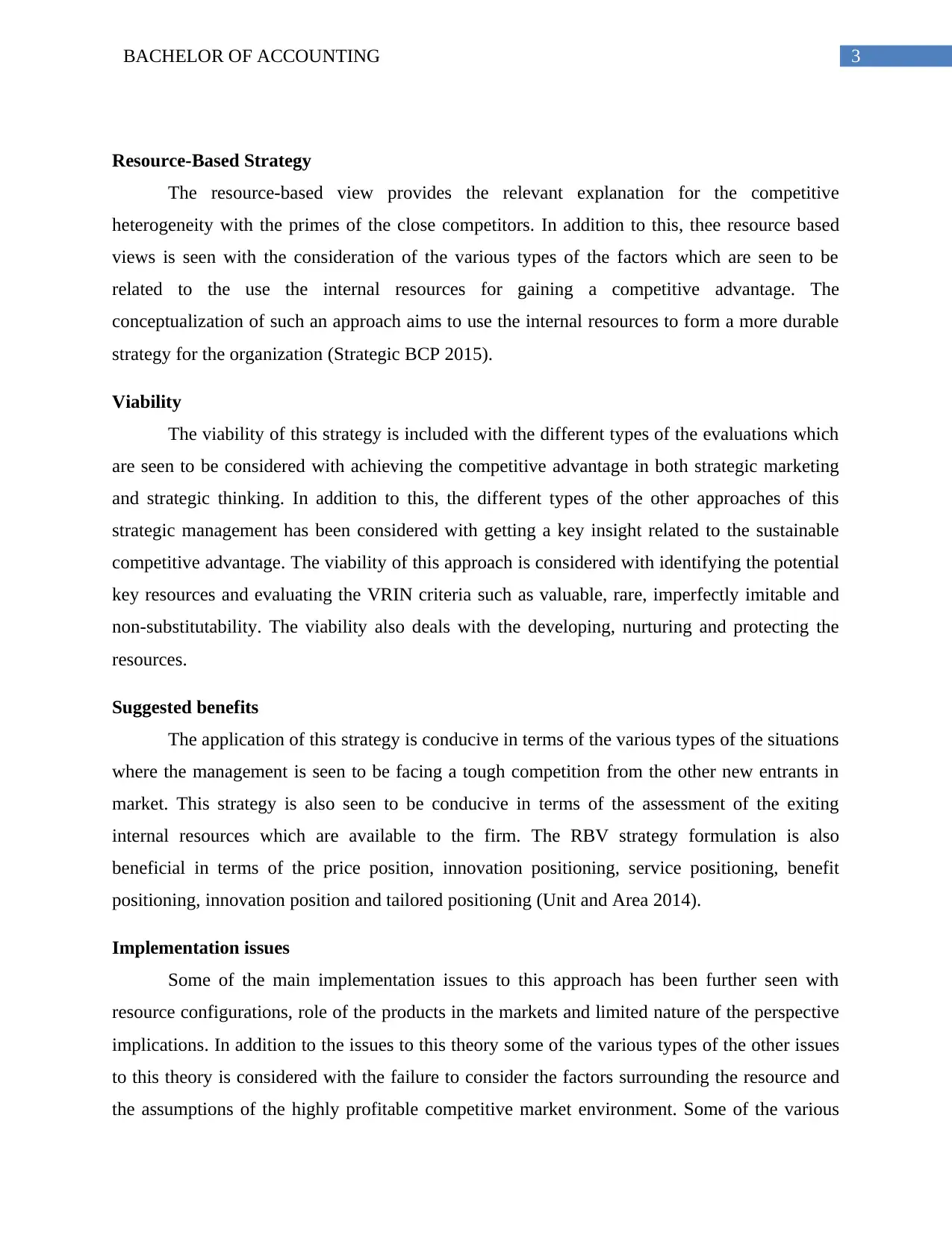
3BACHELOR OF ACCOUNTING
Resource-Based Strategy
The resource-based view provides the relevant explanation for the competitive
heterogeneity with the primes of the close competitors. In addition to this, thee resource based
views is seen with the consideration of the various types of the factors which are seen to be
related to the use the internal resources for gaining a competitive advantage. The
conceptualization of such an approach aims to use the internal resources to form a more durable
strategy for the organization (Strategic BCP 2015).
Viability
The viability of this strategy is included with the different types of the evaluations which
are seen to be considered with achieving the competitive advantage in both strategic marketing
and strategic thinking. In addition to this, the different types of the other approaches of this
strategic management has been considered with getting a key insight related to the sustainable
competitive advantage. The viability of this approach is considered with identifying the potential
key resources and evaluating the VRIN criteria such as valuable, rare, imperfectly imitable and
non-substitutability. The viability also deals with the developing, nurturing and protecting the
resources.
Suggested benefits
The application of this strategy is conducive in terms of the various types of the situations
where the management is seen to be facing a tough competition from the other new entrants in
market. This strategy is also seen to be conducive in terms of the assessment of the exiting
internal resources which are available to the firm. The RBV strategy formulation is also
beneficial in terms of the price position, innovation positioning, service positioning, benefit
positioning, innovation position and tailored positioning (Unit and Area 2014).
Implementation issues
Some of the main implementation issues to this approach has been further seen with
resource configurations, role of the products in the markets and limited nature of the perspective
implications. In addition to the issues to this theory some of the various types of the other issues
to this theory is considered with the failure to consider the factors surrounding the resource and
the assumptions of the highly profitable competitive market environment. Some of the various
Resource-Based Strategy
The resource-based view provides the relevant explanation for the competitive
heterogeneity with the primes of the close competitors. In addition to this, thee resource based
views is seen with the consideration of the various types of the factors which are seen to be
related to the use the internal resources for gaining a competitive advantage. The
conceptualization of such an approach aims to use the internal resources to form a more durable
strategy for the organization (Strategic BCP 2015).
Viability
The viability of this strategy is included with the different types of the evaluations which
are seen to be considered with achieving the competitive advantage in both strategic marketing
and strategic thinking. In addition to this, the different types of the other approaches of this
strategic management has been considered with getting a key insight related to the sustainable
competitive advantage. The viability of this approach is considered with identifying the potential
key resources and evaluating the VRIN criteria such as valuable, rare, imperfectly imitable and
non-substitutability. The viability also deals with the developing, nurturing and protecting the
resources.
Suggested benefits
The application of this strategy is conducive in terms of the various types of the situations
where the management is seen to be facing a tough competition from the other new entrants in
market. This strategy is also seen to be conducive in terms of the assessment of the exiting
internal resources which are available to the firm. The RBV strategy formulation is also
beneficial in terms of the price position, innovation positioning, service positioning, benefit
positioning, innovation position and tailored positioning (Unit and Area 2014).
Implementation issues
Some of the main implementation issues to this approach has been further seen with
resource configurations, role of the products in the markets and limited nature of the perspective
implications. In addition to the issues to this theory some of the various types of the other issues
to this theory is considered with the failure to consider the factors surrounding the resource and
the assumptions of the highly profitable competitive market environment. Some of the various
Paraphrase This Document
Need a fresh take? Get an instant paraphrase of this document with our AI Paraphraser
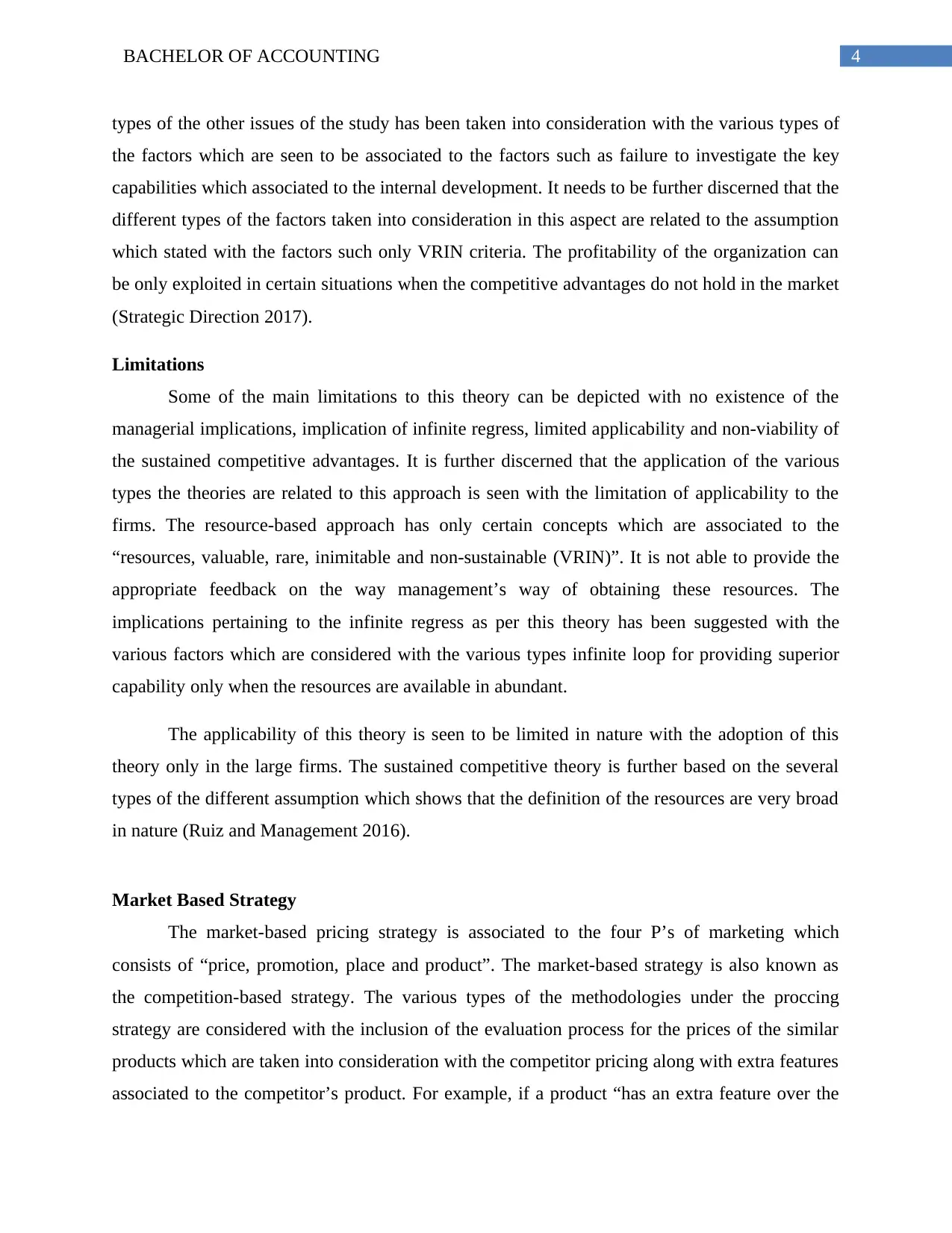
4BACHELOR OF ACCOUNTING
types of the other issues of the study has been taken into consideration with the various types of
the factors which are seen to be associated to the factors such as failure to investigate the key
capabilities which associated to the internal development. It needs to be further discerned that the
different types of the factors taken into consideration in this aspect are related to the assumption
which stated with the factors such only VRIN criteria. The profitability of the organization can
be only exploited in certain situations when the competitive advantages do not hold in the market
(Strategic Direction 2017).
Limitations
Some of the main limitations to this theory can be depicted with no existence of the
managerial implications, implication of infinite regress, limited applicability and non-viability of
the sustained competitive advantages. It is further discerned that the application of the various
types the theories are related to this approach is seen with the limitation of applicability to the
firms. The resource-based approach has only certain concepts which are associated to the
“resources, valuable, rare, inimitable and non-sustainable (VRIN)”. It is not able to provide the
appropriate feedback on the way management’s way of obtaining these resources. The
implications pertaining to the infinite regress as per this theory has been suggested with the
various factors which are considered with the various types infinite loop for providing superior
capability only when the resources are available in abundant.
The applicability of this theory is seen to be limited in nature with the adoption of this
theory only in the large firms. The sustained competitive theory is further based on the several
types of the different assumption which shows that the definition of the resources are very broad
in nature (Ruiz and Management 2016).
Market Based Strategy
The market-based pricing strategy is associated to the four P’s of marketing which
consists of “price, promotion, place and product”. The market-based strategy is also known as
the competition-based strategy. The various types of the methodologies under the proccing
strategy are considered with the inclusion of the evaluation process for the prices of the similar
products which are taken into consideration with the competitor pricing along with extra features
associated to the competitor’s product. For example, if a product “has an extra feature over the
types of the other issues of the study has been taken into consideration with the various types of
the factors which are seen to be associated to the factors such as failure to investigate the key
capabilities which associated to the internal development. It needs to be further discerned that the
different types of the factors taken into consideration in this aspect are related to the assumption
which stated with the factors such only VRIN criteria. The profitability of the organization can
be only exploited in certain situations when the competitive advantages do not hold in the market
(Strategic Direction 2017).
Limitations
Some of the main limitations to this theory can be depicted with no existence of the
managerial implications, implication of infinite regress, limited applicability and non-viability of
the sustained competitive advantages. It is further discerned that the application of the various
types the theories are related to this approach is seen with the limitation of applicability to the
firms. The resource-based approach has only certain concepts which are associated to the
“resources, valuable, rare, inimitable and non-sustainable (VRIN)”. It is not able to provide the
appropriate feedback on the way management’s way of obtaining these resources. The
implications pertaining to the infinite regress as per this theory has been suggested with the
various factors which are considered with the various types infinite loop for providing superior
capability only when the resources are available in abundant.
The applicability of this theory is seen to be limited in nature with the adoption of this
theory only in the large firms. The sustained competitive theory is further based on the several
types of the different assumption which shows that the definition of the resources are very broad
in nature (Ruiz and Management 2016).
Market Based Strategy
The market-based pricing strategy is associated to the four P’s of marketing which
consists of “price, promotion, place and product”. The market-based strategy is also known as
the competition-based strategy. The various types of the methodologies under the proccing
strategy are considered with the inclusion of the evaluation process for the prices of the similar
products which are taken into consideration with the competitor pricing along with extra features
associated to the competitor’s product. For example, if a product “has an extra feature over the
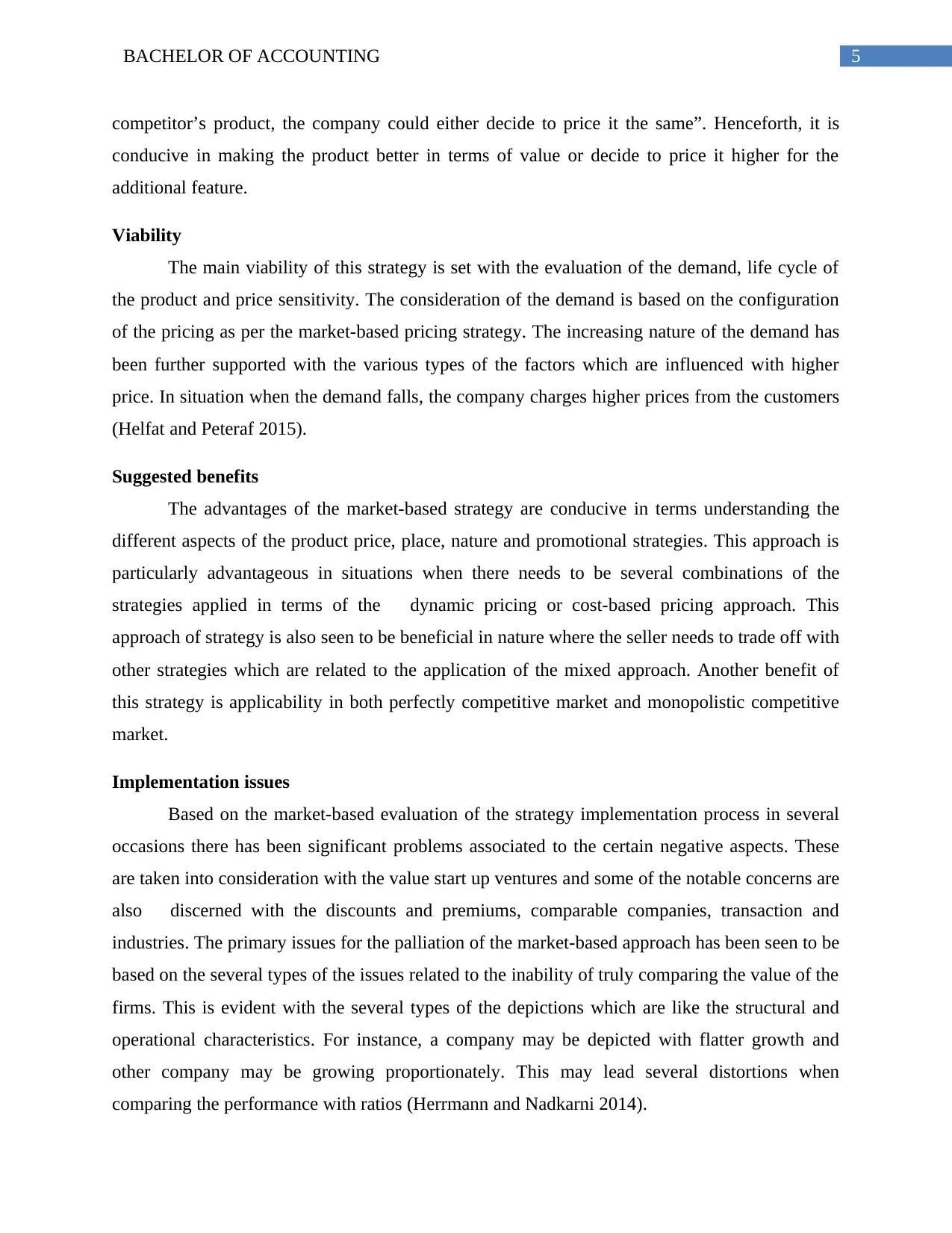
5BACHELOR OF ACCOUNTING
competitor’s product, the company could either decide to price it the same”. Henceforth, it is
conducive in making the product better in terms of value or decide to price it higher for the
additional feature.
Viability
The main viability of this strategy is set with the evaluation of the demand, life cycle of
the product and price sensitivity. The consideration of the demand is based on the configuration
of the pricing as per the market-based pricing strategy. The increasing nature of the demand has
been further supported with the various types of the factors which are influenced with higher
price. In situation when the demand falls, the company charges higher prices from the customers
(Helfat and Peteraf 2015).
Suggested benefits
The advantages of the market-based strategy are conducive in terms understanding the
different aspects of the product price, place, nature and promotional strategies. This approach is
particularly advantageous in situations when there needs to be several combinations of the
strategies applied in terms of the dynamic pricing or cost-based pricing approach. This
approach of strategy is also seen to be beneficial in nature where the seller needs to trade off with
other strategies which are related to the application of the mixed approach. Another benefit of
this strategy is applicability in both perfectly competitive market and monopolistic competitive
market.
Implementation issues
Based on the market-based evaluation of the strategy implementation process in several
occasions there has been significant problems associated to the certain negative aspects. These
are taken into consideration with the value start up ventures and some of the notable concerns are
also discerned with the discounts and premiums, comparable companies, transaction and
industries. The primary issues for the palliation of the market-based approach has been seen to be
based on the several types of the issues related to the inability of truly comparing the value of the
firms. This is evident with the several types of the depictions which are like the structural and
operational characteristics. For instance, a company may be depicted with flatter growth and
other company may be growing proportionately. This may lead several distortions when
comparing the performance with ratios (Herrmann and Nadkarni 2014).
competitor’s product, the company could either decide to price it the same”. Henceforth, it is
conducive in making the product better in terms of value or decide to price it higher for the
additional feature.
Viability
The main viability of this strategy is set with the evaluation of the demand, life cycle of
the product and price sensitivity. The consideration of the demand is based on the configuration
of the pricing as per the market-based pricing strategy. The increasing nature of the demand has
been further supported with the various types of the factors which are influenced with higher
price. In situation when the demand falls, the company charges higher prices from the customers
(Helfat and Peteraf 2015).
Suggested benefits
The advantages of the market-based strategy are conducive in terms understanding the
different aspects of the product price, place, nature and promotional strategies. This approach is
particularly advantageous in situations when there needs to be several combinations of the
strategies applied in terms of the dynamic pricing or cost-based pricing approach. This
approach of strategy is also seen to be beneficial in nature where the seller needs to trade off with
other strategies which are related to the application of the mixed approach. Another benefit of
this strategy is applicability in both perfectly competitive market and monopolistic competitive
market.
Implementation issues
Based on the market-based evaluation of the strategy implementation process in several
occasions there has been significant problems associated to the certain negative aspects. These
are taken into consideration with the value start up ventures and some of the notable concerns are
also discerned with the discounts and premiums, comparable companies, transaction and
industries. The primary issues for the palliation of the market-based approach has been seen to be
based on the several types of the issues related to the inability of truly comparing the value of the
firms. This is evident with the several types of the depictions which are like the structural and
operational characteristics. For instance, a company may be depicted with flatter growth and
other company may be growing proportionately. This may lead several distortions when
comparing the performance with ratios (Herrmann and Nadkarni 2014).
⊘ This is a preview!⊘
Do you want full access?
Subscribe today to unlock all pages.

Trusted by 1+ million students worldwide
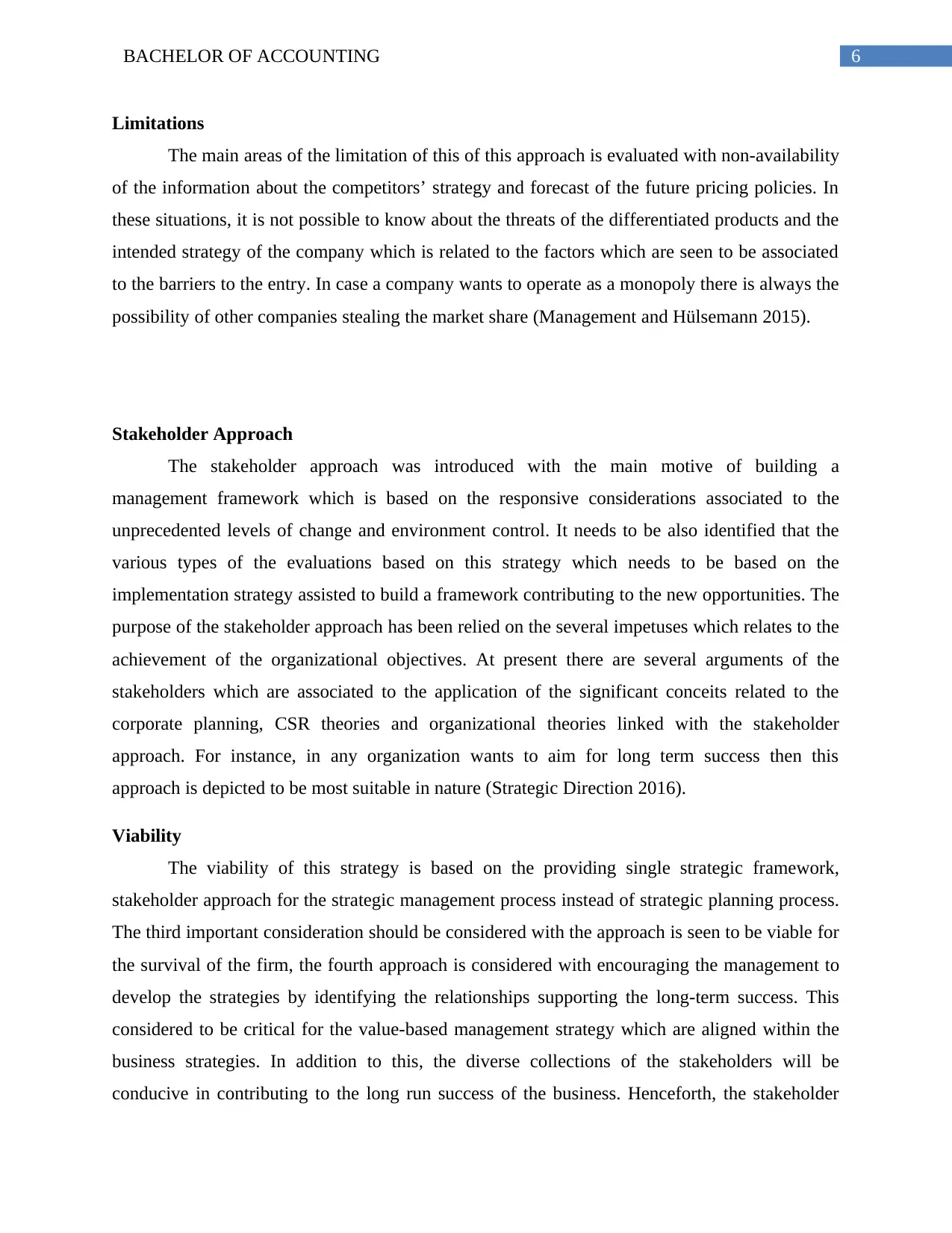
6BACHELOR OF ACCOUNTING
Limitations
The main areas of the limitation of this of this approach is evaluated with non-availability
of the information about the competitors’ strategy and forecast of the future pricing policies. In
these situations, it is not possible to know about the threats of the differentiated products and the
intended strategy of the company which is related to the factors which are seen to be associated
to the barriers to the entry. In case a company wants to operate as a monopoly there is always the
possibility of other companies stealing the market share (Management and Hülsemann 2015).
Stakeholder Approach
The stakeholder approach was introduced with the main motive of building a
management framework which is based on the responsive considerations associated to the
unprecedented levels of change and environment control. It needs to be also identified that the
various types of the evaluations based on this strategy which needs to be based on the
implementation strategy assisted to build a framework contributing to the new opportunities. The
purpose of the stakeholder approach has been relied on the several impetuses which relates to the
achievement of the organizational objectives. At present there are several arguments of the
stakeholders which are associated to the application of the significant conceits related to the
corporate planning, CSR theories and organizational theories linked with the stakeholder
approach. For instance, in any organization wants to aim for long term success then this
approach is depicted to be most suitable in nature (Strategic Direction 2016).
Viability
The viability of this strategy is based on the providing single strategic framework,
stakeholder approach for the strategic management process instead of strategic planning process.
The third important consideration should be considered with the approach is seen to be viable for
the survival of the firm, the fourth approach is considered with encouraging the management to
develop the strategies by identifying the relationships supporting the long-term success. This
considered to be critical for the value-based management strategy which are aligned within the
business strategies. In addition to this, the diverse collections of the stakeholders will be
conducive in contributing to the long run success of the business. Henceforth, the stakeholder
Limitations
The main areas of the limitation of this of this approach is evaluated with non-availability
of the information about the competitors’ strategy and forecast of the future pricing policies. In
these situations, it is not possible to know about the threats of the differentiated products and the
intended strategy of the company which is related to the factors which are seen to be associated
to the barriers to the entry. In case a company wants to operate as a monopoly there is always the
possibility of other companies stealing the market share (Management and Hülsemann 2015).
Stakeholder Approach
The stakeholder approach was introduced with the main motive of building a
management framework which is based on the responsive considerations associated to the
unprecedented levels of change and environment control. It needs to be also identified that the
various types of the evaluations based on this strategy which needs to be based on the
implementation strategy assisted to build a framework contributing to the new opportunities. The
purpose of the stakeholder approach has been relied on the several impetuses which relates to the
achievement of the organizational objectives. At present there are several arguments of the
stakeholders which are associated to the application of the significant conceits related to the
corporate planning, CSR theories and organizational theories linked with the stakeholder
approach. For instance, in any organization wants to aim for long term success then this
approach is depicted to be most suitable in nature (Strategic Direction 2016).
Viability
The viability of this strategy is based on the providing single strategic framework,
stakeholder approach for the strategic management process instead of strategic planning process.
The third important consideration should be considered with the approach is seen to be viable for
the survival of the firm, the fourth approach is considered with encouraging the management to
develop the strategies by identifying the relationships supporting the long-term success. This
considered to be critical for the value-based management strategy which are aligned within the
business strategies. In addition to this, the diverse collections of the stakeholders will be
conducive in contributing to the long run success of the business. Henceforth, the stakeholder
Paraphrase This Document
Need a fresh take? Get an instant paraphrase of this document with our AI Paraphraser

7BACHELOR OF ACCOUNTING
approach is discerned to be critical for the value-based management integrated within the
business.
Suggested benefits
The significants benefits to the single stakeholder will be advantageous in understanding
of the concrete stakeholder relationship. The reference of the stakeholder approach is considered
with the fiduciary duty of management to benefit for all the stakeholders. The stakeholder theory
has been also seen with several initiatives which is conducive in influencing the profit of the
company. The use of stakeholder has been useful in supporting the overall growth of the
organization (Project Management Institute (PMI) 2016).
Implementation issues
The main critical issues are considered as theoretical issues to this approach which has
been analysed with its differences existing in compare to0 the other theories. The empirical
evidences from the separation thesis has been marked with several problems which has shown
that the theory is not applicable in situations where ethics or politics is dissimilar in nature. The
different types of the personal values are embedded in our actions, therefore unless the theory
approves this concept it cannot be applied to the “stakeholder approach within business ethics
and because of the continued neglect of a stakeholder approach in the area of strategic
management”. The theorists have further argued that the that this theory is not practical in nature.
There have been no foundations to this supported by the economics or business theory. In
addition to this, “the approach to business research would challenge the idea that there is a
separate world where business is business and where the fundamental principles, self-interest,
unfettered competition and the maximizing of shareholder wealth, have already been discovered”
(Group 2014).
Limitations
The main limitations to this theory has been traced with the application of this theory in
the real-world application. In several occasions in case firm have no autonomy, then there is
difficulty in understanding of the “meaning of corporate strategy or the role of management”.
The problems have been formulated with the difficulties related to the understanding of the
autonomy of the firm. The difficulty in understanding of the autonomy is seen to be related to the
problems associated to understanding of the corporate strategy related to the role of the
approach is discerned to be critical for the value-based management integrated within the
business.
Suggested benefits
The significants benefits to the single stakeholder will be advantageous in understanding
of the concrete stakeholder relationship. The reference of the stakeholder approach is considered
with the fiduciary duty of management to benefit for all the stakeholders. The stakeholder theory
has been also seen with several initiatives which is conducive in influencing the profit of the
company. The use of stakeholder has been useful in supporting the overall growth of the
organization (Project Management Institute (PMI) 2016).
Implementation issues
The main critical issues are considered as theoretical issues to this approach which has
been analysed with its differences existing in compare to0 the other theories. The empirical
evidences from the separation thesis has been marked with several problems which has shown
that the theory is not applicable in situations where ethics or politics is dissimilar in nature. The
different types of the personal values are embedded in our actions, therefore unless the theory
approves this concept it cannot be applied to the “stakeholder approach within business ethics
and because of the continued neglect of a stakeholder approach in the area of strategic
management”. The theorists have further argued that the that this theory is not practical in nature.
There have been no foundations to this supported by the economics or business theory. In
addition to this, “the approach to business research would challenge the idea that there is a
separate world where business is business and where the fundamental principles, self-interest,
unfettered competition and the maximizing of shareholder wealth, have already been discovered”
(Group 2014).
Limitations
The main limitations to this theory has been traced with the application of this theory in
the real-world application. In several occasions in case firm have no autonomy, then there is
difficulty in understanding of the “meaning of corporate strategy or the role of management”.
The problems have been formulated with the difficulties related to the understanding of the
autonomy of the firm. The difficulty in understanding of the autonomy is seen to be related to the
problems associated to understanding of the corporate strategy related to the role of the
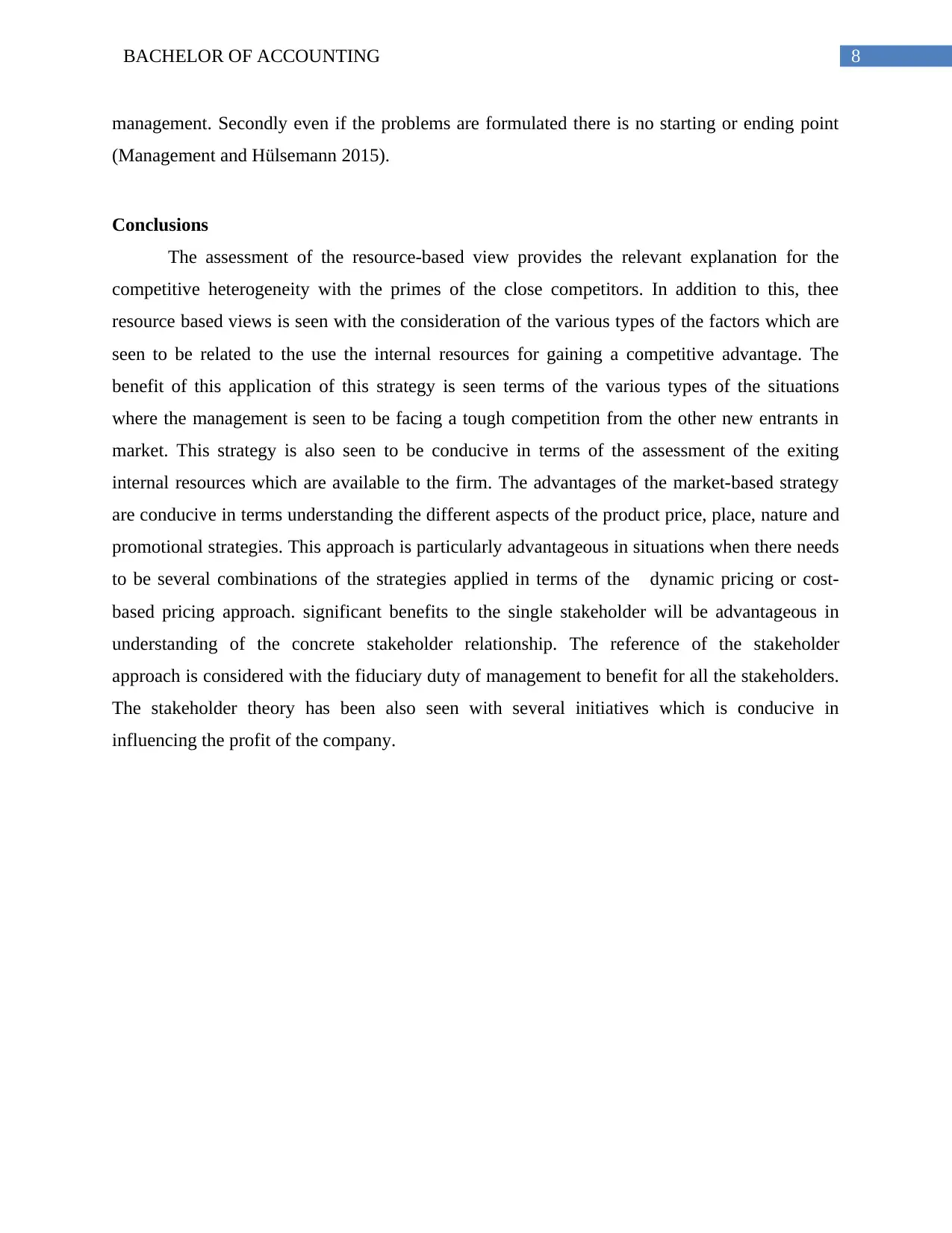
8BACHELOR OF ACCOUNTING
management. Secondly even if the problems are formulated there is no starting or ending point
(Management and Hülsemann 2015).
Conclusions
The assessment of the resource-based view provides the relevant explanation for the
competitive heterogeneity with the primes of the close competitors. In addition to this, thee
resource based views is seen with the consideration of the various types of the factors which are
seen to be related to the use the internal resources for gaining a competitive advantage. The
benefit of this application of this strategy is seen terms of the various types of the situations
where the management is seen to be facing a tough competition from the other new entrants in
market. This strategy is also seen to be conducive in terms of the assessment of the exiting
internal resources which are available to the firm. The advantages of the market-based strategy
are conducive in terms understanding the different aspects of the product price, place, nature and
promotional strategies. This approach is particularly advantageous in situations when there needs
to be several combinations of the strategies applied in terms of the dynamic pricing or cost-
based pricing approach. significant benefits to the single stakeholder will be advantageous in
understanding of the concrete stakeholder relationship. The reference of the stakeholder
approach is considered with the fiduciary duty of management to benefit for all the stakeholders.
The stakeholder theory has been also seen with several initiatives which is conducive in
influencing the profit of the company.
management. Secondly even if the problems are formulated there is no starting or ending point
(Management and Hülsemann 2015).
Conclusions
The assessment of the resource-based view provides the relevant explanation for the
competitive heterogeneity with the primes of the close competitors. In addition to this, thee
resource based views is seen with the consideration of the various types of the factors which are
seen to be related to the use the internal resources for gaining a competitive advantage. The
benefit of this application of this strategy is seen terms of the various types of the situations
where the management is seen to be facing a tough competition from the other new entrants in
market. This strategy is also seen to be conducive in terms of the assessment of the exiting
internal resources which are available to the firm. The advantages of the market-based strategy
are conducive in terms understanding the different aspects of the product price, place, nature and
promotional strategies. This approach is particularly advantageous in situations when there needs
to be several combinations of the strategies applied in terms of the dynamic pricing or cost-
based pricing approach. significant benefits to the single stakeholder will be advantageous in
understanding of the concrete stakeholder relationship. The reference of the stakeholder
approach is considered with the fiduciary duty of management to benefit for all the stakeholders.
The stakeholder theory has been also seen with several initiatives which is conducive in
influencing the profit of the company.
⊘ This is a preview!⊘
Do you want full access?
Subscribe today to unlock all pages.

Trusted by 1+ million students worldwide
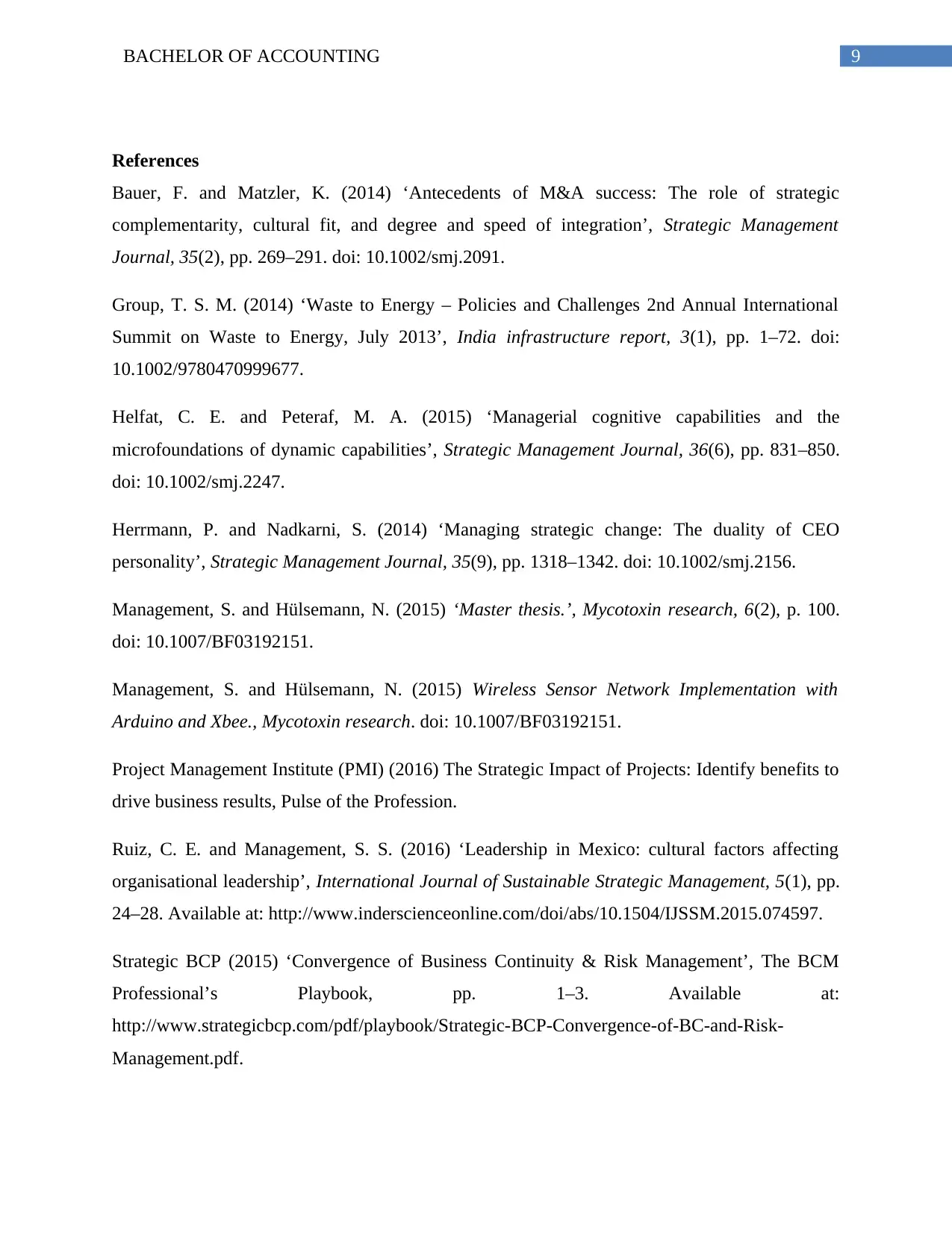
9BACHELOR OF ACCOUNTING
References
Bauer, F. and Matzler, K. (2014) ‘Antecedents of M&A success: The role of strategic
complementarity, cultural fit, and degree and speed of integration’, Strategic Management
Journal, 35(2), pp. 269–291. doi: 10.1002/smj.2091.
Group, T. S. M. (2014) ‘Waste to Energy – Policies and Challenges 2nd Annual International
Summit on Waste to Energy, July 2013’, India infrastructure report, 3(1), pp. 1–72. doi:
10.1002/9780470999677.
Helfat, C. E. and Peteraf, M. A. (2015) ‘Managerial cognitive capabilities and the
microfoundations of dynamic capabilities’, Strategic Management Journal, 36(6), pp. 831–850.
doi: 10.1002/smj.2247.
Herrmann, P. and Nadkarni, S. (2014) ‘Managing strategic change: The duality of CEO
personality’, Strategic Management Journal, 35(9), pp. 1318–1342. doi: 10.1002/smj.2156.
Management, S. and Hülsemann, N. (2015) ‘Master thesis.’, Mycotoxin research, 6(2), p. 100.
doi: 10.1007/BF03192151.
Management, S. and Hülsemann, N. (2015) Wireless Sensor Network Implementation with
Arduino and Xbee., Mycotoxin research. doi: 10.1007/BF03192151.
Project Management Institute (PMI) (2016) The Strategic Impact of Projects: Identify benefits to
drive business results, Pulse of the Profession.
Ruiz, C. E. and Management, S. S. (2016) ‘Leadership in Mexico: cultural factors affecting
organisational leadership’, International Journal of Sustainable Strategic Management, 5(1), pp.
24–28. Available at: http://www.inderscienceonline.com/doi/abs/10.1504/IJSSM.2015.074597.
Strategic BCP (2015) ‘Convergence of Business Continuity & Risk Management’, The BCM
Professional’s Playbook, pp. 1–3. Available at:
http://www.strategicbcp.com/pdf/playbook/Strategic-BCP-Convergence-of-BC-and-Risk-
Management.pdf.
References
Bauer, F. and Matzler, K. (2014) ‘Antecedents of M&A success: The role of strategic
complementarity, cultural fit, and degree and speed of integration’, Strategic Management
Journal, 35(2), pp. 269–291. doi: 10.1002/smj.2091.
Group, T. S. M. (2014) ‘Waste to Energy – Policies and Challenges 2nd Annual International
Summit on Waste to Energy, July 2013’, India infrastructure report, 3(1), pp. 1–72. doi:
10.1002/9780470999677.
Helfat, C. E. and Peteraf, M. A. (2015) ‘Managerial cognitive capabilities and the
microfoundations of dynamic capabilities’, Strategic Management Journal, 36(6), pp. 831–850.
doi: 10.1002/smj.2247.
Herrmann, P. and Nadkarni, S. (2014) ‘Managing strategic change: The duality of CEO
personality’, Strategic Management Journal, 35(9), pp. 1318–1342. doi: 10.1002/smj.2156.
Management, S. and Hülsemann, N. (2015) ‘Master thesis.’, Mycotoxin research, 6(2), p. 100.
doi: 10.1007/BF03192151.
Management, S. and Hülsemann, N. (2015) Wireless Sensor Network Implementation with
Arduino and Xbee., Mycotoxin research. doi: 10.1007/BF03192151.
Project Management Institute (PMI) (2016) The Strategic Impact of Projects: Identify benefits to
drive business results, Pulse of the Profession.
Ruiz, C. E. and Management, S. S. (2016) ‘Leadership in Mexico: cultural factors affecting
organisational leadership’, International Journal of Sustainable Strategic Management, 5(1), pp.
24–28. Available at: http://www.inderscienceonline.com/doi/abs/10.1504/IJSSM.2015.074597.
Strategic BCP (2015) ‘Convergence of Business Continuity & Risk Management’, The BCM
Professional’s Playbook, pp. 1–3. Available at:
http://www.strategicbcp.com/pdf/playbook/Strategic-BCP-Convergence-of-BC-and-Risk-
Management.pdf.
Paraphrase This Document
Need a fresh take? Get an instant paraphrase of this document with our AI Paraphraser

10BACHELOR OF ACCOUNTING
Strategic Direction (2016) ‘Social media as the path to a marketing strategy: Companies must
become “curators” to meet the challenge’, Strategic Direction, 32(2), pp. 20–22. doi:
10.1108/SD-11-2015-0169.
Strategic Direction (2017) ‘For local startup success, look abroad’, Strategic Direction, 33(5), pp.
36–38. doi: 10.1108/SD-02-2017-0034.
Unit, M. and Area, E. (2014) ‘Corporate Social Responsibility and Access to Finance’, Strategic
Management Journal, 23(April 2013), pp. 1–23. doi: 10.1002/smj.
Strategic Direction (2016) ‘Social media as the path to a marketing strategy: Companies must
become “curators” to meet the challenge’, Strategic Direction, 32(2), pp. 20–22. doi:
10.1108/SD-11-2015-0169.
Strategic Direction (2017) ‘For local startup success, look abroad’, Strategic Direction, 33(5), pp.
36–38. doi: 10.1108/SD-02-2017-0034.
Unit, M. and Area, E. (2014) ‘Corporate Social Responsibility and Access to Finance’, Strategic
Management Journal, 23(April 2013), pp. 1–23. doi: 10.1002/smj.
1 out of 11
Related Documents
Your All-in-One AI-Powered Toolkit for Academic Success.
+13062052269
info@desklib.com
Available 24*7 on WhatsApp / Email
![[object Object]](/_next/static/media/star-bottom.7253800d.svg)
Unlock your academic potential
Copyright © 2020–2025 A2Z Services. All Rights Reserved. Developed and managed by ZUCOL.




